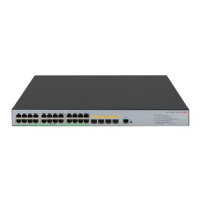332
By configuring per-source or per-source-and-group load splitting, you can optimize the traffic delivery
when multiple IPv6 multicast data streams are handled.
To configure an IPv6 multicast routing policy:
Ste
Command
Remarks
1. Enter system view.
system-view N/A
2. Configure the device to select
the RPF route based on the
longest match.
multicast ipv6 longest-match
Optional.
The route with the highest priority is
selected as the RPF route by
default.
3. Configure IPv6 multicast load
splitting.
multicast ipv6 load-splitting
{source | source-group }
Optional.
Disabled by default.
This command does not take effect
in IPv6 BIDIR-PIM.
Configuring an IPv6 multicast forwarding range
IPv6 multicast packets do not travel infinitely in a network. The IPv6 multicast data of each IPv6 multicast
group must be transmitted within a definite scope.
You can configure the forwarding boundary for a specific IPv6 multicast group or an IPv6 multicast group
with the scope field in its group address being specified on all interfaces that support IPv6 multicast
forwarding. A multicast forwarding boundary sets the boundary condition for the IPv6 multicast groups
in the specified range or scope. If the destination address of an IPv6 multicast packet matches the set
boundary condition, the packet will not be forwarded. Once an IPv6 multicast boundary is configured
on an interface, this interface can no longer forward IPv6 multicast packets (including those sent from the
local device) or receive IPv6 multicast packets.
To configure an IPv6 multicast forwarding range:
Ste
Command
Remarks
1. Enter system view.
system-view N/A
2. Enter interface view.
interface interface-type
interface-number
N/A
3. Configure an IPv6 multicast
forwarding boundary.
multicast ipv6 boundary
{ ipv6-group-address prefix-length |
scope { scope-id | admin-local |
global | organization-local |
site-local } }
No forwarding boundary by
default.
Configuring the IPv6 multicast forwarding table size
The switch maintains the corresponding forwarding entry for each IPv6 multicast packet that it receives.
Excessive IPv6 multicast routing entries, however, can exhaust the switch's memory and cause lower

